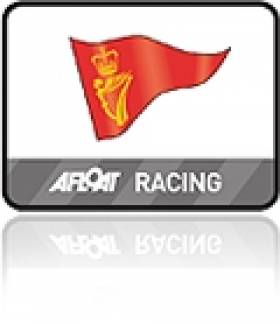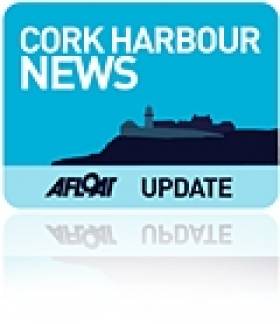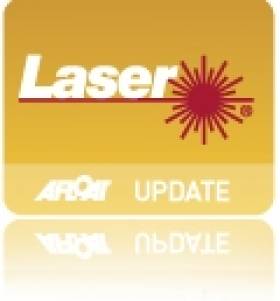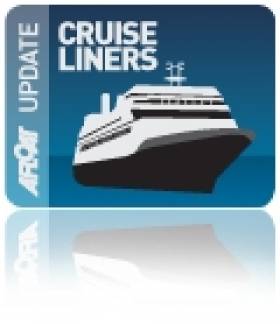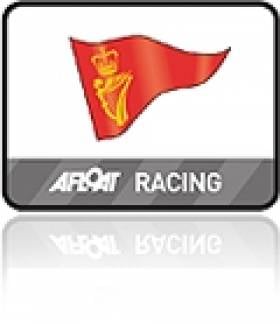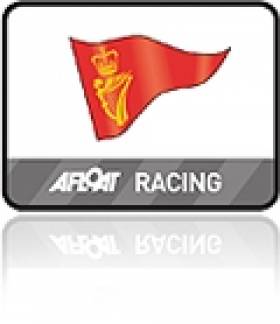Displaying items by tag: Cork Harbour
Big Breeze for Second Race of Royal Cork Autumn Regatta
Strong westerlies that swept Royal Cork's Yacht Club's George Kenefick to success at the All Ireland championships on Lough Derg also blew for the second race of his club's Autumn regatta in Cork Harbour today writes Claire Bateman. Bob Bateman's action photos are below.
It was a day that kept the best wine until last. There was much sailing activity in the harbour with some seventy five cruisers sailing their various courses and some ninety dinghies from Optimists to Laser 4.7s sailing in a strong westerly breeze with warm overtones . Although the wind was there all day, and plenty of it, when the sun broke through in the early afternoon it created that special Cork Harbour sailing ambience.
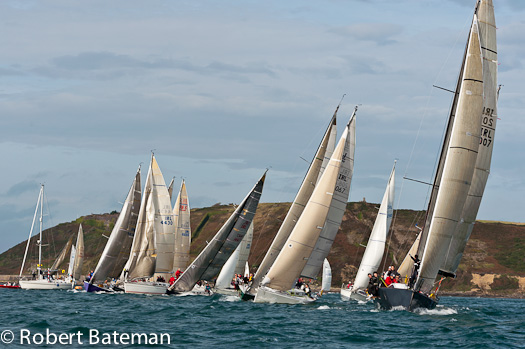
A great start for the Autumn fleet. Photo: Bob Bateman. More pics below
Classes Three, Four, and Whitesail 1 and 2 sailed on the Eastern Bank with Race Officer Richard Leonard and he started with a triangle course followed by a windward/leeward course. There was plenty of excitement on this course with mention of Chinese gybes. The Dorgan Sonar from Cove Sailing Club revelled in the conditions and got the better of Ian Travers' Bandit from Kinsale (currently for sale on the Afloat boats for sale site here) while Michael Murphy's Shelly D had won the day in ECHO with Alan Mulcahy's Sundancer from Kinsale taking IRC.
Meanwhile on the Red Course with Race Officer David O'Brien it was a perfect day for the 1720s and fleets 1 and 2. Your scribe was watching the second race that started inside the harbour just inside Roches Point on a beat in a strong flood tide to W2, a screaming reach to Harp, a beat back to W2, back to W1 before a number of dramatically tight finishes near the Cage. The 1720s displayed the best of One Design racing as they came into W2 with one boat becoming the meat in the sandwich between the buoy and the fleet with no quarter being given and had to do their penalty turn. In the best 1720 tradition, despite the high, wind they hoisted their kites as they went hither and thither before most got sense and finally dropped their kites.
On the day it was Denis Murphy's Aquatack from the home club took the honours followed Peter O'Flynn's Two 2 Tango.At the time of prizegiving Class 2 were still involved with protests but first again this week on IRC was Brian Goggin's Allure (KYC) followed by the Desmond/Deasy/Ivers Bad Company from the home club. In Class Zero IRC in a reversal of last week's results Kieran and Brian Twomeys' Gloves Off got the better of Conor Phelan's Jump Juice on the day. In Class 1 IRC David Scott's EOS again took the spoils but Dan Buckley's Justus was going very well and took the second slot.
As Rear Admiral Cruisers Ronan Enright had promised, the prizegiving was bang on 5.30pm with the prizes being presented by Frank O'Flynn of the Sponsor Company who incidentally had been sailing on the Peter O'Flynn Two 2 Tango 1720.
Racing continues in the O'Flynn Exhams sponsored league next Sunday with a first gun at 11.55am.
€40m Clean Up of Cork Harbour Toxi Dump Ordered
"This is going to come as an enormous relief to the people of Cobh who have quite rightly feared for the health of their community for over ten years with unchecked emissions of a carcinogenic toxin, Chromium VI, coming from an unlicenced landfill," the Ireland South MEP said in Brussels today.
"While a baseline health study has never been carried out, the National Cancer Registry of Ireland proves that the rate of cancer in Cobh is 37% higher than the national average. Furthermore, we cannot forget the environmental and economic concerns also at the fore of the Haulbowline campaign."
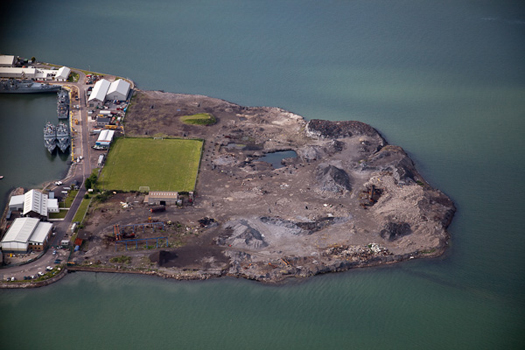
Haulbowline - A €40m clean up has been announced. Photo: Bob Bateman
Mr Kelly, who tirelessly lobbied for action on the site, is now hopeful that this part of his Cork constituency can look towards future economic growth with positivity: "This toxic dump is located in a very scenic part of Ireland and while it is difficult to measure its impact in monetary terms, no one can deny its existence has had a detrimental effect on Cobh's tourism potential.
"Earlier this year, the European Commission directed Irish authorities to take decisive action on the landfill within a three month timeframe under threat of court action. The warning followed a petition of over 5,000 signatures calling for immediate action, I brought before a parliamentary committee in conjunction with Cork Harbour Health pressure group," the MEP continued.
Mr Kelly believes the previous government, the EPA and Cork County Council 'passed the buck on Haulbowline in a disgraceful way'. However, with Cabinet approval of 20m in the 2012 budget and 20m in the 2013 budget due for the restoration of the area, 'it is time to look towards a brighter future for Cobh and Haulbowline Island', according to Mr Kelly.
Day One of the Autumn Sailing Regatta commenced at 8.30 am yesterday when Royal Cork Yacht Club was jam packed and rocking with the excitement of the Ireland vs Italy rugby match writes Claire Bateman. (SCROLL DOWN FOR GALLERY)
After the glorious Irish victory the fleets headed out into the mist hoping that a bit of breeze would fill in. The mood was buoyant and the atmosphere sizzling but alas and alack on attempting to set a course the hard working David O'Brien, Principal Race Officer for Classes 3, 4 and whitesail, on Admiral Paddy McGlade's Sabone, would appear to have encountered the wrath of the weather gods who must have been rooting for the Italians today! As the Race Officer described it "the fog would roll away for some 200 yards and some minutes later it would roll back in again" and at times it was raining and other times it was dry.
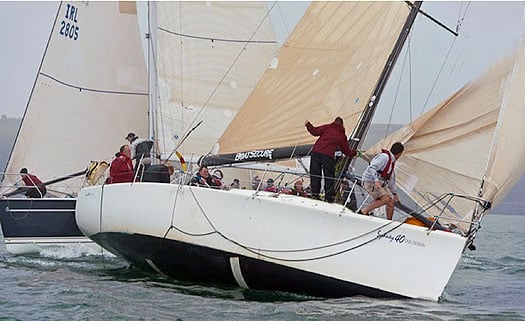
Once the fog lifted, there was some breeze for racing. Photo: Bob Bateman. More photos below.
The fog descended and visibility was so reduced he couldn't even see the pin end of the line that had just been laid. However, after a short delay the a small breeze filled and the fog lifted sufficently to enable a start. Class 3 were first away with the exception of Outrigger who had to return to start having been over the line. Then it was the turn of the Whitesail fleet who headed off into the mist accompanied by a number of dolphins.
Meanwhile Classes 0, 1, 2 and 1720s, under PRO Richard Leonard, stayed in the harbour where they sailed windward/leeward courses with a start off Spike and despite the conditions they managed two races . The committee boat for these fleets was kindly provided by Paschal Healy who had on board the Senior partner of the sponsor firm, Irene O'Donovan, assisting with Race duties. In the second race for these fleets Buoys 10 and 16 were used for the windward/leeward course giving Classes 0 and 1720s three rounds and Class 1 two rounds. Towards the final round the wind died and crews struggled to round 16 before the wind filled in enough to get all boats finished.
Given the conditions it was a wonderful achievement to get in any racing at all for the large fleet on the day and hopefully next Sundays' racing will enjoy better conditions and will return to the scheduled start time of 11.55am.
New Sponsor for Cork Laser Frostbites
Fram From the Fjords and Beyond
Fram operates on cruises from Norway to Spitsbergen, Greenland, and Europe. She also cruises in Antarctic waters and explores the Chilean fjords. She can handle 400 passengers in 254 berths. On board there is a reception area, a large top-deck glass-enclosed observation salon positioned forward, bar, restaurant, library, shop and leisure facilities, including gym, sauna and jacuzzi. For further information and deck plans click HERE.
Throughout her interior she has traditional and modern artwork from a selection of Norwegian and Greenlandic artists. To read more on her Antarctic cruises and other destinations click HERE.
On this particular cruise, she had departed from Bergin and called to several Scottish ports prior to berthing in Belfast and docking in Dublin yesterday. This evening she heads for the Isles of Scilly, followed by a call to Portsmouth before disembarking her passengers in Hamburg.
Brisk Sailing for Royal Cork's Naval Race (Photos here)
There was a great sailing breeze for today's Royal Cork Naval Race in Cork harbour and the appearance of the Navy's own Sail Training Yacht Creidne added to the occasion at Haulbowline writes Claire Bateman. Scroll down for photos.
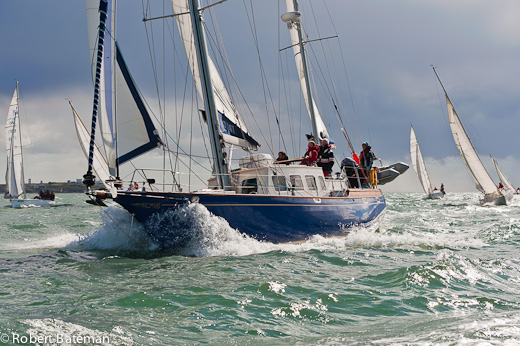
The Defence Forces STY Creidne shows her pace in Cork Harbour in today's Royal Cork Yacht Club Naval Race. Photo: Bob Bateman. More photos below
The second fleet to start, comprising of Classes Three, Four and White Sail Class that included many Class One boats, were given a reaching start in the harbour into Corkbeg, a beat across to Cage, a run back to Corkbeg, a reach in the harbour and a beat to the finish before arriving at the Naval Base.
For this scribe the highlight of the event was to watch the Creidne with her gleaming blue topsides joust with Táilte. Creidne being a bigger boat with a longer waterline and ketch rig had the legs on Táilte on the reach but Táilte was pointing higher on the beat, had more manoeuverability and got ahead at Cage. On the reach back to Corkbeg Creidne again showed her speed to round Corkbeg just behind Táilte. It was great sailing and well done to both crews and their helmsMeanwhile in Class Three the Jimmy Nyhan/Maritta Buwalda Outrigger was making all the running and were using their asymmetric spinnaker to good effect and despite the best efforts of the J24 and the Impalas they couldn't catch them.
The conditions were such that the white sail boats were having a ball but as the fleet were rounding the Spit Bank a squall struck and took away some of the pleasure. However, it was soon to clear before the merry band arrived at the Naval Base to enjoy well earned and most generous hospitality provided by the Naval Service.
Kenefick to Skipper Cork Entry at Student Yachting World Cup
Twenty three year old George, who will graduate with an Honours Degree this coming November, is now training hard with fellow crewmembers, including Joe Bruen and Kevin Goulding. Joe competed successfully in the 1720 Europeans this year and with George, sailed "Tiger" to success at the IRC Nationals in Class 3.
CIT have enjoyed success previously at the Student Yachting World Championships in La-Trinite-sur Mer, France in 2008. It will be George's fourth time competing, having represented CIT for each of his undergraduate years.
O'Leary Set for Tomorrow's New York Cup
Anthony O'Leary's crew are all set for tomorrow's start of the New York Yacht Club Invitational Cup as sole Irish crew representing Royal Cork Yacht Club in the Big Apple.
The grounds of New York Yacht Club's renowned Harbour Court clubhouse in Newport, Rhode Island, were filled with sailors from around the world, who are set to begin racing tomorrow in the second biennial Invitational Cup presented by Rolex.
The 22 teams, representing yacht clubs from 16 nations and six continents, have traveled far and wide to get to Newport. The teams, especially those less familiar with the Swan 42 class, enjoyed several perfect practice days with today's 12-14 knot southwesterly breeze, under sunshine and brilliant blue skies, appreciated by all competitors, especially those from some more sunshine-challenged locales
The Swan 42s, an ultra competitive one-design class, were conceived by the NYYC as the yacht club's ninth one-design class since its' founding in 1844. The New York Yacht Club Race Committee, led by John "Tinker" Myles, Jr. ran several practice starts today for the fleet.
Racing will run from Tuesday, 13 September through Saturday, 17 September. A total of eleven (windward-leeward) races are planned, with no throw-outs. Racing will take place off Newport, R.I. on Rhode Island Sound or in Narragansett Bay.
One of the first teams to arrive in Newport was Clube Naval de Cascais from Portugal, with skipper Patrick Moteiro de Barros. The team has been on-site for over a week practicing on their chartered Swan 42 Orbit, and making the most of coach Bill Shore's expertise and local knowledge. de Barros commented, "The goal is to do the best we can, and we're here to win. We may not win, but that's the motivation."
To that end de Barros, who is a four-time Olympian, has assembled a crew that at its' core are very competitive Dragon sailors. Included in this mix is tactician Henrique Anjos, a three-time Portuguese national champion in the class. With no Swan 42s available locally, the team came up with a clever alternative last spring, chartering a Dufour 40, and adding a bowsprit to it so they could fly an asymetrical spinnaker.
De Barros is no stranger to Newport, having sailed here in the 1980s when he was the helmsman on Magic, the trial horse for Dennis Conner's Freedom. The team had hoped to participate two years ago, but couldn't come, and the appeal of the event is clear to de Barros who added, "The Invitational Cup is totally Corinthian, and I think it's important to have events where the amateurs are recognized. This is one of the most prestigious yacht clubs in the world, and I think events like this should carry on."
From further afield is the Royal Hong Kong Yacht Club team with skipper Nick Burns. Sailing onboard is Jochim Isler, Vice Commodore of the club and a frequent competitor in the RHKYC's signature biennial Rolex China Sea Race. As with many of the other clubs, the teams experience is in a mix of big boats and one-designs, in this case Etchells. Burns and Isler often compete against each other, but they've solidified their strengths as well as recruited 10 of the top 20 sailors in the club for the team.
In the 2009 event, Royal Hong Kong finished 11th; but last summer they sailed in the Rolex Commodore's Cup and finished second, which Isler said gave them the confidence and motivation to give it a try again.
Burns added, "We came a long way for this, it's great. The event is tightening up (rules) year-by-year, which is what you need. They're doing a very equal job with the boats, it's a very good system. You have nothing to blame but yourself!"
One of the Southern hemisphere teams competing is the Yacht Club Argentino with Paolo Cosentino as helmsman. YCA Commodore Ricardo Galarce is racing onboard as trimmer, and the two were clearly delighted to be here, "This is our first visit and I tell you we are amazed, we want to live here, we're going to stay here."
Cosentino said, "We sail two boats that are similar (a Frers 44 and a Soto 43). We trained about 10 days in Buenos Aires (in the river) and Mar del Plata, where you can sail in the sea. We feel comfortable, but need to train a little more – we've had these three days here, so we'll arrive tomorrow at about 80% of our standard.
"For us we are very proud of being invited by this club. We have a lot of tradition also, our club is almost 130 years old and for us being here is a very special situation – we are very proud."
For NYYC Invitational Cup Event Chairman, John Mendez tomorrow's start couldn't come soon enough, "I'm absolutely delighted. To be honest it's been a long build-up, it's been two years getting this going and to see all of the teams arrive and to meet with them – their excitement and enthusiasm -- has really set this off for me. I feel a lot more relaxed about the whole event!"
About half of the yacht club teams that competed in 2009 are back again, including the top five. Mendez continued, "We still have a lot of interest from yacht clubs that are not here and as this has grown they'll be a lot more who'll want to participate next time. I see the competition this time being stiffer than last time – it has been raised to another level. I think we'll see some exciting racing.
"This is key to each one of these clubs – they all have the intention of taking the trophy back with them. I'm afraid we can't cut it into pieces! But, I could see the trophy leaving our shores at the end of the week."
This edition features a couple of significant changes including a move to all-amateur sailors (no professionals) and on-the-water umpiring. Of the latter Mendez points out, "That's a very big leap forward for fleet racing. We want people to sail safely and the umpiring is definitely going to help that."
In addition to Rolex, which for 2011 and 2013 is the presenting sponsor, Sperry Top-Sider and Nautor's Swan have also returned, and are joined by Atlantis WeatherGear, as sponsors to enhance the experience of competitors as well as those who will be following the races.
The 22 entrants
By country, the roster of participating teams is: Yacht Club Argentino (ARG); Cruising Yacht Club of Australia (AUS); Royal Bermuda Yacht Club (BER); Royal Canadian Yacht Club (CAN); Royal Hong Kong Yacht Club (CHN); Real Club Nautico de Barcelona (ESP); Nyländska Jaktklubben (FIN); Itchenor Sailing Club, Royal Ocean Racing Club and Royal Yacht Squadron (GBR); Norddeutscher Regatta Verein (GER); Royal Cork Yacht Club (IRL); Yacht Club Capri and Yacht Club Punta Ala (ITA); Japan Sailing Federation (JPN); Royal Norwegian Yacht Club (NOR); Clube Naval de Cascais (POR); Royal Cape Yacht Club (RSA); Eastern Yacht Club, Annapolis Yacht Club, Newport Harbor Yacht Club and New York Yacht Club (USA)
Cavatina Takes Win on Ringabella Course
Results Summary
1st in White Sail IRC Ian Hickey's Granada 38 "Cavatina"
1st in White Sail Echo Batt O'Leary's Sun Odyssey 36i "Sweet Dreams"
1st in Class 3 IRC Jimmy Nyhan & Maritta Buwalda's 1/4 Tonner "Outrigger"
1st in Class 3 Echo Sarah Hyde's J24 "Junebug"
1st in Class 2 IRC Ted Crosbie's X302 "No Excuse"
1st in Class 2 Echo Leonard Donnery's Nicholson 33 "No Gnomes"
1st in Class 1 IRC Kieran Twomey's Corby 38 "Gloves Off"
1st in Class 1 Echo Coleman Garvey & Martin Darrer's Projection 35 "True Penance"
Queen Elizabeth Arrives Exactly on Schedule
Despite the squally and blustery conditions, the 294m Cunard Line cruiseship was assisted by the tug Gerry O'Sullivan, was swung swing around in the turning basin off Cobh with the consumate skill of her master Captain Christopher Wells. She eased alongside the deepwater cruise berth fifty minutes later with the first mooring line cast off from the bow to an awaiting lines-boat at 09.00hrs, as exactly scheduled.


























